文章信息
- 邢庆会, 韩广轩, 于君宝, 吴立新, 杨利琼, 毛培利, 王光美, 谢宝华
- XING Qinghui, HAN Guangxuan, YU Junbao, WU Lixin, YANG Liqiong, MAO Peili, WANG Guangmei, XIE Baohua
- 黄河口潮间盐沼湿地生长季净生态系统CO2交换特征及其影响因素
- Net ecosystem CO2 exchange and its controlling factors during the growing season in an inter-tidal salt marsh in the Yellow River Estuary, China
- 生态学报, 2014, 34(17): 4966-4979
- Acta Ecologica Sinica, 2014, 34(17): 4966-4979
- http://dx.doi.org/10.5846/stxb201310312627
-
文章历史
- 收稿日期:2013-10-31
- 网络出版日期:2014-3-5
2. 中国科学院大学, 北京 100049;
3. 黄河三角洲国家级自然保护区管理局, 东营 257091
2. University of Chinese Academy of Sciences, Beijing 100049, China;
3. Administration Bureau of the Yellow River Delta National Nature Reserve, Dongying 257091, China
潮间盐沼湿地处于海陆交互地带[1],生产力高,有机质分解速率较低[2, 3, 4],有利于碳积累。另外,潮间盐沼湿地的泥砂质海滩受到潮流、波浪和径流等的共同影响[5, 6],使得有机物质、沉积物等产生横向和纵向输运,带来外来碳堆积[7, 8],甚至可形成厚达15 m的泥炭层[9, 10, 11]。因此,虽然全球盐沼湿地仅占湿地总面积的5%,但是它对全球碳平衡的影响是其他同等规模湿地的10倍[12],在全球碳循环中发挥着重要作用。然而,全球变暖造成的海平面上升、海岸侵蚀加速以及土地利用方式的转变都会使潮间盐沼湿地的面积不断减少[13, 14],从而影响盐沼湿地的碳汇功能。目前对潮间盐沼湿地生态系统尺度碳交换特征及其影响因素的研究十分有限。 Kathilankal等[3]在2007年,利用开路式涡度相关观测系统,第一次量化了潮汐淹水对潮间盐沼湿地NEE的影响,目前为止,潮汐淹水对其碳交换影响的研究数据仍非常稀缺。这不仅阻碍了预测湿地对全球变化响应的研究,也限制了理解和预测潮间盐沼湿地对海平面上升的响应。
黄河口近海与海岸湿地是暖温带增长速度最快和最具代表性的新生近海与海岸湿地,具有海陆过渡性、原生性和脆弱性的特点[15, 16],受水沙量变化、陆地和河流淡水径流、咸水海流多重影响,导致其CO2交换存在着极大的复杂性和不确定性。黄河口潮间盐沼湿地是我国北方典型的潮间盐沼湿地类型之一,地势平坦,面积为1.0×105 hm2[17],物种组成非常简单,植被以盐地碱蓬(Suaeda salsa)为优势种[18],成片状分布[19]。黄河口潮间盐沼湿地生态系统碳过程有何特征? 其CO2源/汇功能如何? 目前对于该类生态系统的CO2交换研究尚没有连续的数据进行报道。本文以微气象-涡度相关观测系统获得的2012年生长季通量数据为基础进行分析研究,专注于生态系统与大气间CO2垂直交换。以期达到以下研究目的: (1)掌握黄河口潮间盐沼湿地生态系统CO2收支的日变化和季节变化规律。(2)解析潮间盐沼湿地生态系统CO2交换对光合有效辐射、温度、土壤含水量,尤其是潮汐作用等环境因子变化的响应规律。(3)评价黄河口潮间盐沼湿地生态系统的CO2源/汇功能。
1 材料和方法 1.1 研究区域概况研究地点位于中国科学院黄河三角洲滨海湿地生态试验站的潮间带观测场(37°40′54" N—38°10′54" N,118°41′41" E—119°16′41" E,海拔3—5 m),通量塔位于黄河以北约3 km(37°46′54" N,119°9′41" E) (图 1)。研究区属于典型的暖温带半湿润大陆性季风气候,年平均气温12.9 ℃。年平均日照时数2590―2830 h,年平均无霜期211 d,多年平均降水量551.6 mm,年平均蒸散量750—2400 mm[20]。年平均风速2.98 m/s,且常年盛行东北风与东南风[21, 22]。土壤类型为滨海潮盐土,土壤质地为砂质黏壤土,有机质含量丰富,土壤发育年轻,生长季通量塔附近10 cm深处土壤盐度波动范围为0.20%—0.81%。植物群落组成简单,以盐地碱蓬(Suaeda salsa)为优势种,伴生有柽柳(Tamarix chinensis)和芦苇(Phragmites australis)[23]。黄河三角洲潮间带植被分局格局清晰[24],通量塔周围地形平坦,植物群落生长茂盛,外貌整齐,盐地碱蓬高度在20—27 cm,植被盖度为30%左右,最大地上生物量333.72 g/m2。盐地碱蓬为1年生草本植物,4月为生长初期,7月开花,9月底成熟,11月衰败[25, 26]。
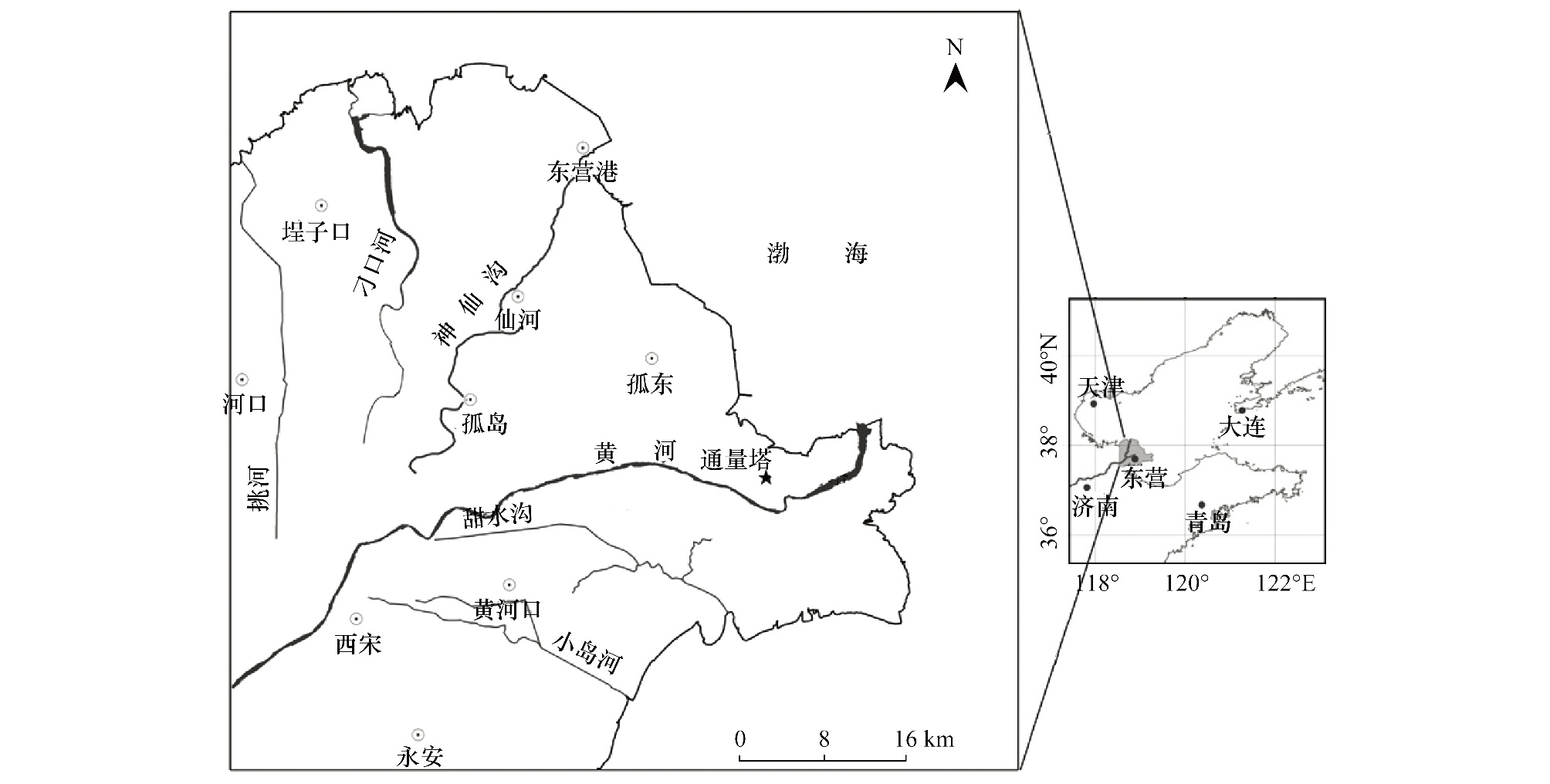
|
| 图 1 黄河口潮间盐沼湿地通量塔位置 Fig. 1 Location of flux tower in an inter-tidal salt marsh of the Yellow River Estuary |
潮间盐沼湿地LI-7500A开路式涡度相关观测系统安装高度为2.8 m,由开路式CO2/H2O分析仪(LI-7550,LI-Cor,USA)和三维超声风速仪(GILL-WM,LI-Cor,USA)组成,采样频率为10 Hz,每30 min输出平均值。同时,测定了距地面2.8 m和2 m的光合有效辐射(LI-190SL,LI-Cor,USA)和四分量净辐射(NR01,LI-Cor,USA)以及地面以下5、10、20、30、50 cm处的土壤温度(TM-L10,LI-Cor,USA);5、10、20、30、50 cm处土壤体积含水量(EC-5,LI-Cor,USA)等环境因子。另外,该观测系统的能量平衡系统(DYNAMET,LI-Cor,USA)数据包括风向/风速(3 m)、空气温度/相对湿度(2 m)、降雨量(1.5 m)、太阳总辐射(2.8 m)。以上气象数据通过数据采集器(CR1000,LI-Cor,USA)每30 min自动记录1次。文中潮汐资料借鉴2012年山东东营湾湾沟口潮汐监测站(38°10′59" N,118°27′00" E)的相关数据。该监测站与本实验区同位于黄河以北,为不规则半日潮区[27],能在一定程度上反映本研究区的潮汐变化。
1.3 数据质量控制受电力、仪器故障、探头结霜、天气突变等影响,通量数据不可避免的出现缺失和“野点”[28],因此需要对原始数据进行预处理。首先,剔除降雨前后半小时的数据以及夜间NEE为负值的数据。其次,以-3.5 μmol m-2 s-1<NEE<2 μmol m-2 s-1为阈值标准进行数据初步控制。再次,由于夜间大气层结比较稳定,湍流发展不充分,所以筛选保留夜间摩擦风速大于0.15 m/s的数据,本文通过分段平均和累计平均得出潮间盐沼湿地生态系统夜间摩擦速度的阈值为0.15 m/s(图 2)。

|
| 图 2 潮间盐沼湿地摩擦风速与夜间净生态系统CO2交换 (NEE) 之间的关系 Fig. 2 The relationship between nighttime net ecosystem CO2 exchange (NEE) and friction velocity in an inter-tidal salt marsh |
对缺失的数据进行插补时,连续缺失数据在4个值以内的采用线性内插法。对缺失量大的时间段的数据插补采用非线性经验方程[22]。根据PAR值把每天分为白天段(PAR>10 μmol 光子 m-2 s-1)和黑天段(PAR≤10 μmol 光子 m-2 s-1)[29]。白天缺失NEE数据的插补利用Michaelis-Menten 模型:

式中,NEEdaytime为白天净生态系统CO2交换(μmol CO2 m-2 s-1),α为表观初始光能利用率(μmol CO2 μmol -1 光子),PAR为光合有效辐射(μmol 光子 m-2 s-1),NEEsat为最大光合速率(μmol CO2 m-2 s-1),Rd为表观暗呼吸速率(dark ecosystem respiration in daytime)(μmol CO2 m-2 s-1)。夜间生态系统CO2交换数据采用其与5 cm深处的土壤温度之间的Van′t Hoff函数模拟插补[22, 30]:

式中,Reco,n为夜间生态系统呼吸(μmol CO2 m-2 s-1),Ts5为5 cm深处土壤温度(℃),a、b为模拟计算值,分别指温度为0 ℃时的生态系统呼吸速率(μmol CO2 m-2 s-1)及温度反应系数。用Q10值表示生态系统呼吸速率对温度变化的敏感程度,并通过下式确定Q10值[31]:

式中,b为(2)式中的温度反应系数。
1.5 GPP和RecoGPP可以定义为:

GPP代表植被通过光合作用吸收的CO2,Reco代表生态系统通过呼吸排放的CO2。由于植被夜间不进行光合作用,所以Reco,n与夜间净生态系统CO2交换(NEEnighttime)等同。另外,植被白天生态系统呼吸不易直接测定[32],所以,依据Reco,n与Ts5的函数关系外延来估算白天生态系统呼吸(Reco,d),因此,生态系统呼吸可以定义为:

采用单因素方差分析方法(one-way ANOVA)分析各月NEE平均日变化的差异性以及NEE、GPP和Reco月均值的差异性。运用非线性回归分析方法分析夜间NEE与Ts的关系;用非线性拟合方法分析生长季各月白天NEE与PAR的直角双曲线关系。利用配对样本T检验检验潮汐淹水期和非淹水期的每天NEEdaytime、PAR半小时平均值、NEEnighttime、夜间Ts5半小时平均值之间的差异性。数据分析均基于统计分析软件SPSS 16.0完成,相关的图形均基于Origin 8.5完成。
2 结果与分析 2.1 环境因子基本状况2012年黄河口潮间盐沼湿地生长季(4—10月)PAR日平均值波动范围为44.91—629.65 μmol photon m-2 s-1,月平均最高值出现在5月(468.96 μmol m-2 s-1)。5月份以后因降水增多,PAR离散趋势明显,且呈现下降趋势(图 3)。日平均气温(Ta)为20.93 ℃,7月份月平均气温最高(26.38 ℃),4月份最低(12.74 ℃),生长季昼夜温差小于16.86 ℃。Ts5日平均值为22.61 ℃,与Ta相比,生长季Ts5波动较小(图 3)。2012年生长季总降水量为525.53 mm,集中了全年降水的近81.78%,且7、8月占全年降水量的58.66%(图 3)。5 cm土壤含水量(SWC5)和10 cm土壤含水量(SWC10)变化趋势一致,相关系数达到0.88,其日平均值的变化范围分别为24.99%—34.38%、23.23%—33.68%,且5月份两土层土壤含水量日平均值分别降至27.44%和23.23%(图 3)。湾湾沟口的潮高基准面低于海平面1.3 m,潮汐高潮高度(H)呈现单峰变化,变化范围为1.74—2.81 m,7月份潮高达到最大值(图 3)。
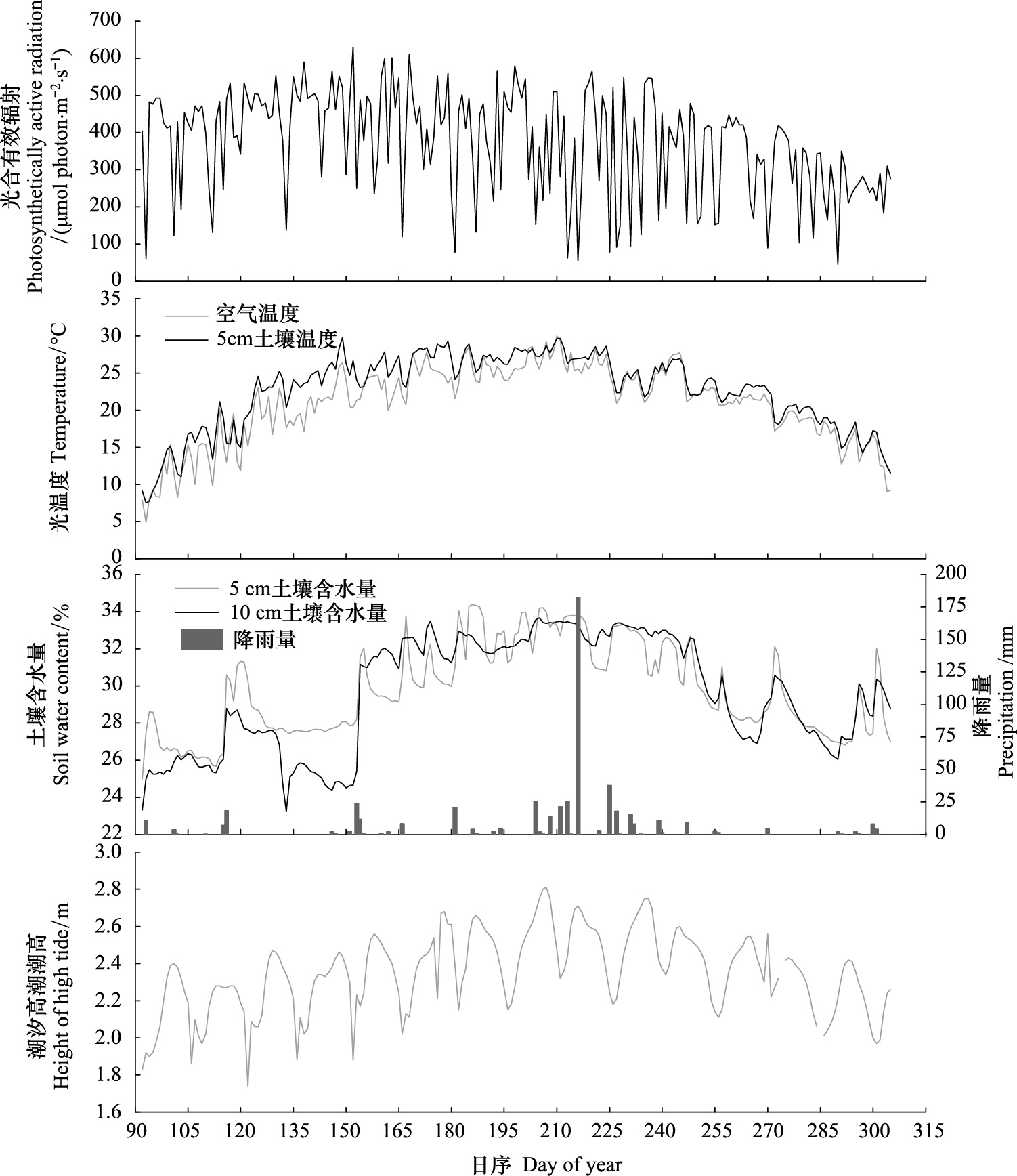
|
| 图 3 2012年生长季潮间盐沼湿地环境因子变化 Fig. 3 Variations of environmental factors in an inter-tidal salt marsh during the growing season of 2012 |
将2012年潮间盐沼湿地生长季的NEE按每月每天从0:00到23:30每0.5 h进行平均,得到生长季NEE日平均变化特征曲线(图 4)。该曲线表明,生长季各月日平均变化均为单峰变化,变化幅度不同。白天NEE均为负值(净CO2吸收),夜间为正值(净CO2排放)。一般在日出后,NEE由正值渐变为负值,增至吸收峰值后又逐渐减弱,直到日落之后转为碳源,且吸收峰一般出现在10:00—14:00。5月白天日平均最大瞬时吸收速率为-1.57 μmol CO2 m-2 s-1,出现在12:00。4月、7月日平均最大瞬时吸收速率出现在12:00之后,6月及8—10月则在12:00之前。6月份白昼时间最长,生态系统对CO2的净吸收状态约从6:20持续到19:20,跨度最长。7月以后净吸收状态持续时间逐渐缩短,至10月份净吸收时间缩短为8:30到16:30。生长季各月夜间基本保持净CO2排放状态,且排放高峰期不尽相同,5、6月在后半夜4:00左右,其他月份在前半夜20:00左右。各月NEE日平均变化幅度不同,8月变化幅度相对5—7月份较小,且在9月逐渐转变为净CO2源。各月净CO2吸收量,6月(-11.08 g C/m2)>5月(-9.30 g C/m2)>7月(-5.89 g C/m2)>4月(-3.74 g C/m2)>8月(-1.55 g C/m2),其中5、6、7月分别贡献了41.73%、49.72%、26.41%。10月,生态系统对CO2的吸收和释放强度都变弱,NEE日变化幅度最小。
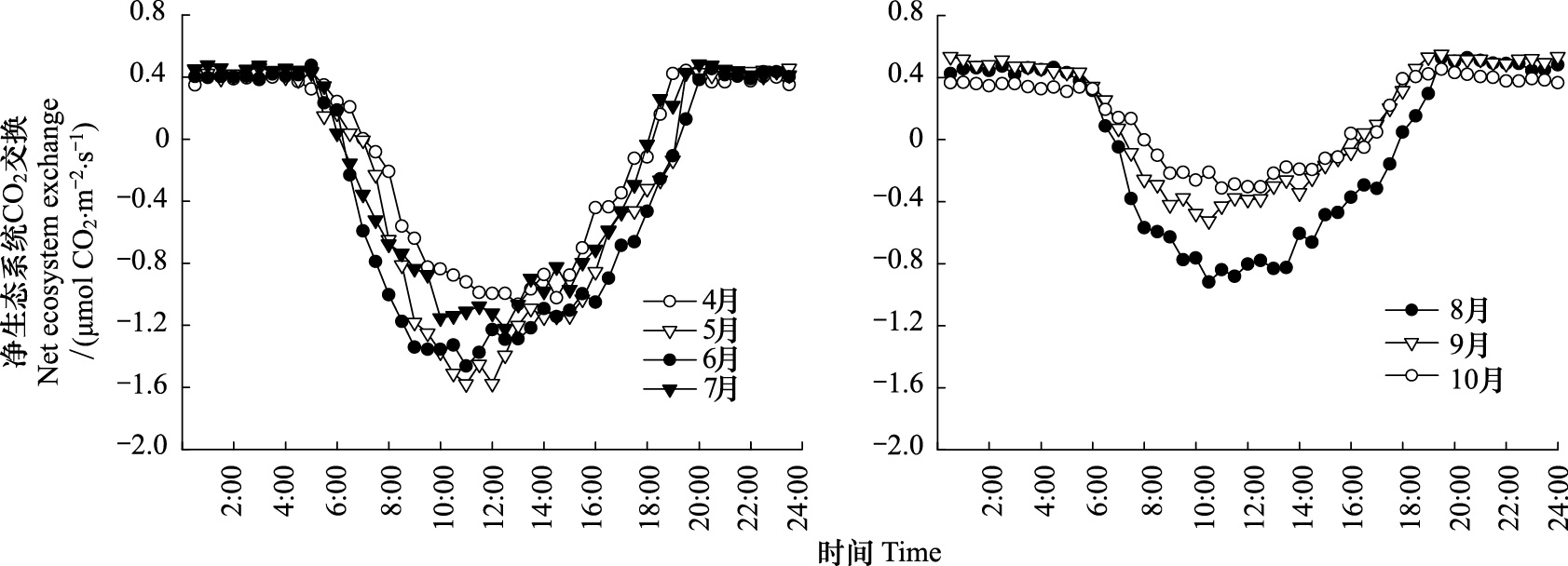
|
| 图 4 黄河口潮间盐沼湿地生长季净生态系统CO2交换 (NEE) 日变化特征 Fig. 4 Diurnal variations of the net ecosystem CO2 exchange (NEE) during the growing season in an inter-tidal salt marsh in the Yellow River Estuary |
2012年潮间盐沼湿地生态系统NEE、GPP和Reco的季节变化均呈现生长初期和末期较低,生长中期较高的分布,但波动幅度不同(图 5)。生长季初期,GPP和Reco数值较小,随着环境的变化和植被的快速生长,分别由生长初期的0.73 g CO2 m-2 d-1(4月2日)和1.04 g CO2 m-2 d-1(4月6日)逐渐增加到最大值4.86 g CO2 m-2 d-1(6月27日)和2.55 g CO2 m-2 d-1(4月23日)。 在温度最高的7月,生态系统 CO2释放量最大,Reco为15.16 g C/m2; 6月,CO2吸收量最大,GPP为25.07 g C/m2。生长季末期,GPP和Reco呈下降趋势,且GPP下降速率大于Reco下降速率,使得该生态系统9月、10月表现为CO2的净排放,NEE为正值。4—8月生态系统净CO2吸收。生长季NEE日平均值为-0.38 g CO2 m-2 d-1,日最大净吸收值和净释放值分别为3.13 g CO2 m-2 d-1(6月27日)和1.47 g CO2 m-2 d-1(8月12日)。生长季潮间盐沼湿地生态系统总体表现为碳汇,CO2净吸收量为22.28 g C/m2,累计吸收CO2为118.34 g C/m2,累计排放CO2为96.28 g C/m2,Reco约占GPP的81.36%(图 5)。
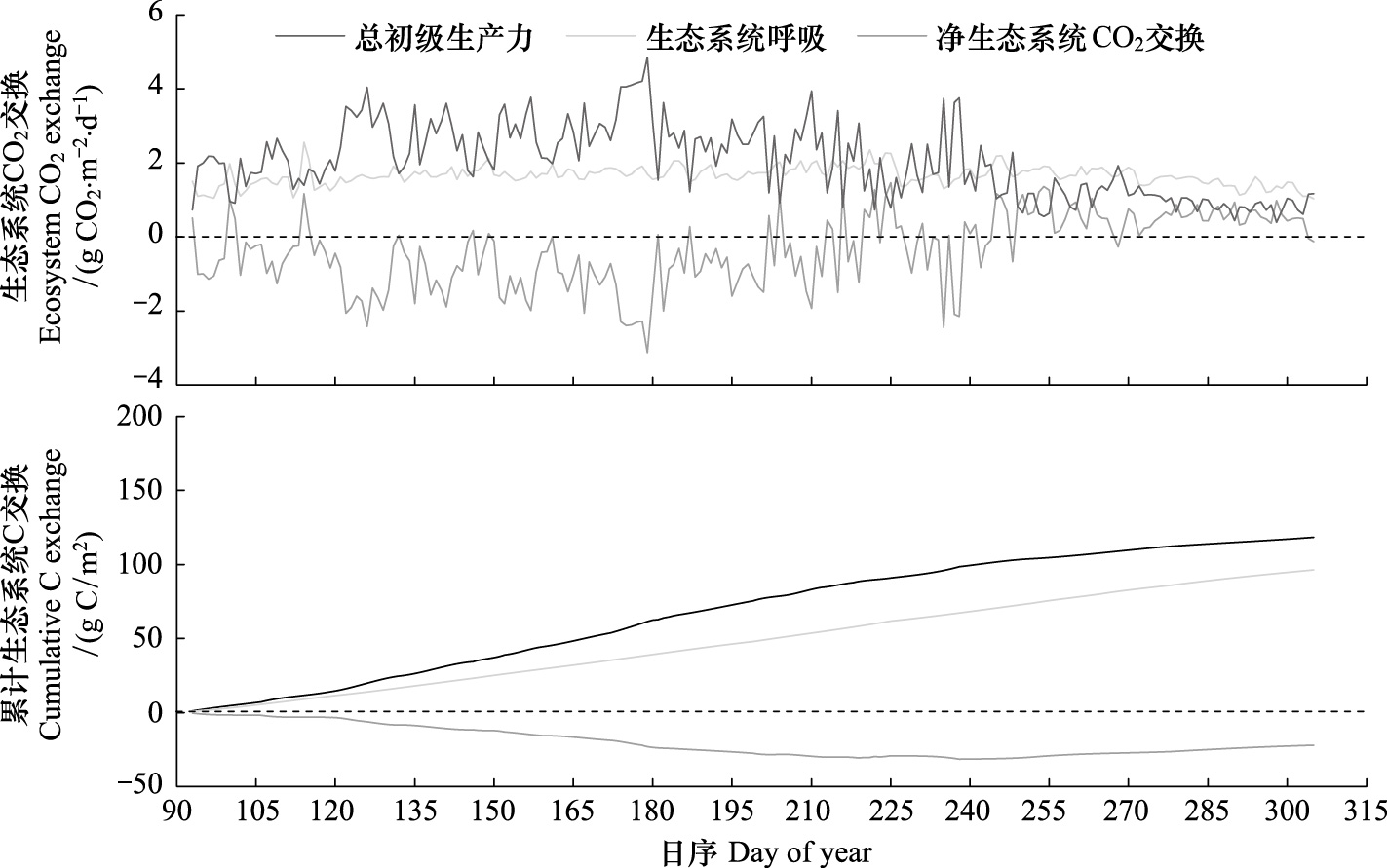
|
| 图 5 黄河口潮间盐沼湿地生态系统2012年生长季净生态系统CO2交换 (NEE) 、总初级生产力 (GPP) 和生态系统呼吸 (Reco) 的动态变化及累计状况 Fig. 5 Dynamic variation and accumulation changes of net ecosystem CO2 exchange (NEE) ,ecosystem gross primary production (GPP) and ecosystem respiration (Reco) in an inter-tidal salt marsh during the growing season of 2012 |
用Michaelis-Menten 模型拟合潮间盐沼湿地生态系统白天NEE与PAR,两者较好地符合直角双曲线关系,各月光曲线拟合参数不同(表 1)。生长季,潮间盐沼湿地生态系统α、NEEsat和Rd的平均值分别为0.0035 μmol CO2 μmol -1 光子、2.25 μmol CO2 m-2 s-1和0.29 μmol CO2 m-2 s-1。α在 0.0010—0.0086 μmol CO2 μmol-1 光子之间波动,且在6月份达到最大值。4月NEEsat为2.66 μmol CO2 m-2 s-1,5月NEEsat达到极值4.79 μmol CO2 m-2 s-1,之后呈下降趋势。Rd在气温最高的7月达到最大值0.45 μmol CO2 m-2 s-1。9月,虽然最大光合速率较小,但是α、NEEsat值均大于相邻月份。
| 月份 Month | 表观初始光能利用率 Apparent quantum yield/ (μmolCO2 μmol-1 光子) | 最大光合速率 Maximum photosynthesis rate/ (μmol CO2 m-2 s-1) | 表观暗呼吸速率 Dark ecosystem respiration in daytime/ (μmol CO2 m-2 s-1) | n | R2 |
| 4 | 0.0017±0.0004 | 2.6606±0.6111 | 0.1912±0.0713 | 468 | 0.39 |
| 5 | 0.0016±0.0003 | 4.7876±1.5189 | 0.1166±0.0644 | 697 | 0.43 |
| 6 | 0.0086±0.0019 | 2.1533±0.0975 | 0.4361±0.1065 | 682 | 0.42 |
| 7 | 0.0042±0.0007 | 2.3809±0.1201 | 0.4502±0.0649 | 736 | 0.52 |
| 8 | 0.0023±0.0006 | 2.0444±0.2443 | 0.2586±0.0737 | 608 | 0.33 |
| 9 | 0.0050±0.0024 | 0.8666±0.0910 | 0.4192±0.1055 | 527 | 0.17 |
| 10 | 0.0010±0.0005 | 0.8304±0.2650 | 0.1742±0.0569 | 333 | 0.18 |
生长季Reco,n与Ts5、SWC10均呈现显著的正相关关系(R2=0.203,P<0.01;R2=0.049,P<0.05),表明Ts5 和SWC10共同影响着潮间盐沼湿地的Reco,n。首先,拟合Reco,n与Ts5的曲线关系(图 6),然后把SWC10按照小于等于25%、25%—30%和大于30%三个区间划分,再分别拟合Reco,n与Ts5的曲线关系(图 6),同时计算Reco,n对土壤温度的敏感性,即Q10值。结果表明:Reco,n随Ts呈指数增加趋势,且土壤含水量越高,Q10值越大。当SWC10≤25%时,Q10仅为1.27,SWC10>30%时,Q10增大至1.67。另外,当SWC10≤25%,Ts5<15℃时的Reco,n 数据全部来自4月,4月Ts5平均值仅为14.53 ℃,Q10值达到2.11。
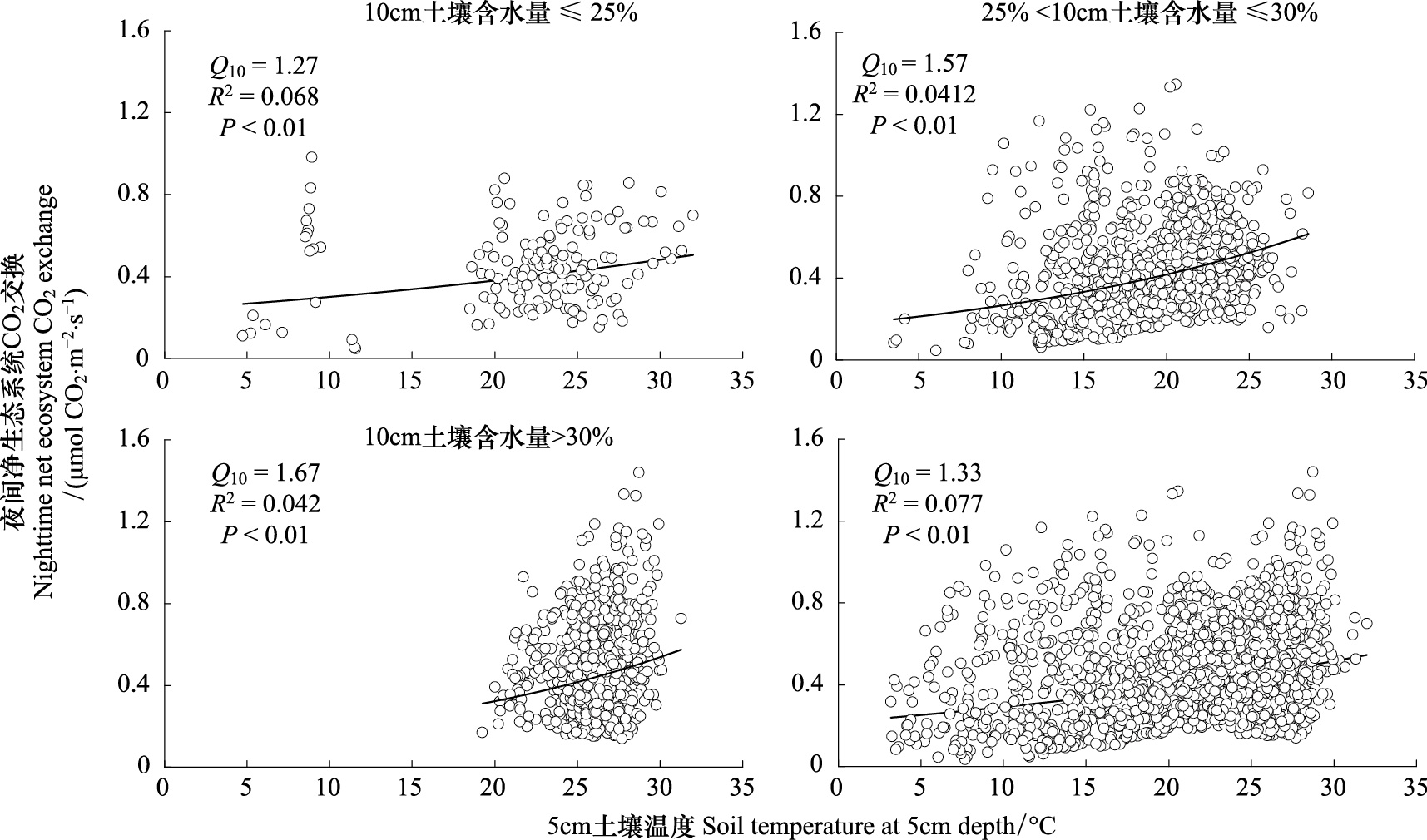
|
| 图 6 2012年潮间盐沼湿地生长季,不同土壤含水量 (SWC) 条件下夜间生态系统CO2交换 (NEEnighttime) 对5 cm土壤温度 (Ts5) 的响应; 夜间生态系统CO2交换 (NEEnighttime) 随5 cm土壤温度 (Ts5) 的变化 Fig. 6 The change of nighttime net ecosystem CO2 exchange (NEEnighttime) in an inter-tidal salt marsh during the growing season of 2012 (to soil temperature at 5 cm depth (Ts5) under different ranges of soil water content at 10 cm depth (SWC10),along with soil temperature at 5 cm depth (Ts5)) |
由于黄河口潮间盐沼湿地处于不规则半日潮区,潮汐过程相对短暂,且植被生长期降雨事件频发,以及每日阴晴云量状况不定,给采集潮汐淹水高质量数据造成困难。该研究选择受潮汐影响较大的典型晴天6月19日—6月25日作为研究时间段。因为SWC10与降雨量和潮汐极显著相关,而研究时间段降雨量为0,且期间湾湾沟口潮汐高度变化范围是2.24—2.6 m,平均值达到2.49 m,这表明SWC10出现的较大波动是由潮汐引起的(表 2)。因此,用SWC10反映潮汐变化过程(图 7)。根据涨落潮过程及SWC10的变化,把研究时间段划分为潮汐淹水期(21—23日)和非淹水期(19—20日与24—25日),并对比潮汐淹水前后每天NEEdaytime、PAR半小时平均值、NEEnighttime、夜间Ts5半小时平均值之间的差异性(表 3)。

|
| 图 7 潮间盐沼湿地生态系统2012年6月19―26日净生态系统CO2交换 (NEE) 与10 cm土壤含水量 (SWC10) 的变化 Fig. 7 Diurnal variations of the net ecosystem CO2 exchange (NEE) and soil water content at 10 cm depth (SWC10) of an inter-tidal salt marsh from June 19 to 26 in 2012 |
| 潮高 Height of high tide | 降雨 Precipitation | 光合有效辐射 Photosynthetically active radiation | |
| *<0.05,**<0.01 | |||
| 5 cm土壤含水量 Soil water content at 5 cm depth | 0.399* * | 0.178* * | 0.017 |
| 10 cm土壤含水量 Soil water content at 10 cm depth | 0.427* * | 0.146* * | -0.039 |
| 地表水文状况 Surface hydrological condition | 白天净生态 系统CO2交换 Daytime net ecosystem CO2 exchange / (μmol CO2 m-2 s-1) | 夜间净生态 系统CO2交换 Nighttime net ecosystem CO2 exchange / (μmol CO2 m-2 s-1) | 光合有效辐射 Photosynthetic active radiation/ (μmol photon m-2 s-1) | 5 cm土壤温度 Soil temperature at 5 cm depth/ ℃ | NEEdaytime与PAR的关系 The relationship of NEEdaytime and PAR | ||
| 表观初始光 能利用率 Apparent quantum yield / (μmolCO2 μmol-1 光子) | 最大光合速率 Maximum photosynthesis rate / (μmol CO2 m-2 s-1) | 表观暗呼吸速率 Dark ecosystem respiration in daytime / (μmol CO2 m-2 s-1) | |||||
| 淹水Tidal inundation | -1.40±0.20 | 0.45±0.05 | 680.69±80.00 | 26.62±0.40 | 0.03±0.01 | 4.20±0.47 | 1.84±0.25 |
| 非淹水Non-flooded | -1.14±0.18 | 0.39±0.07 | 799.19±84.96 | 27.17±0.08 | 0.03±0.01 | 2.70±0.35 | 1.27±0.28 |
| P | <0.05 | >0.05 | <0.001 | <0.001 | |||
在研究时间段内,涨潮过程,SWC10陡增,而退潮过程SWC10呈缓慢减小趋势(图 7)。表 3,潮汐淹水期PAR小于非淹水期PAR,但淹水期NEEdaytime的日平均值(-1.40 μmol CO2 m-2 s-1)却大于非淹水期(-1.14 μmol CO2 m-2 s-1),差异显著(P<0.05);潮汐淹水期夜间Ts5小于非淹水期夜间Ts5,但淹水期NEEnighttime日平均值 (0.45 μmol CO2 m-2 s-1)却大于非淹水期NEEnighttime(0.39 μmol CO2 m-2 s-1),无显著差异(P>0.05)。这表明,潮汐淹水同时增强了生态系统白天对CO2的净吸收和夜间CO2释放。最终,研究时间段内,潮汐淹水使生态系统净CO2吸收增加了0.76 g CO2 m-2 d-1。通过拟合潮汐淹水期和非淹水期NEEdaytime与PAR的关系(表 3),可以看出潮汐淹水期NEEsat大于非淹水期。另外,潮汐淹水期间,NEEnighttime由22日的(0.37±0.05) μmol CO2 m-2 s-1增至23日(0.54±0.10) μmol CO2 m-2 s-1,变化较大(图 7)。
3 讨论 3.1 生态系统白天NEE对PAR的响应绿色植物通过光合作用固定CO2,合成有机物,而光是进行光合作用的前提条件,植物光合作用的光响应曲线描述的正是PAR与植物净光合作用速率之间的关系[33, 34]。本研究发现,生态系统白天NEE与PAR较好地符合直角双曲线关系(表 1),这与以往很多研究结果一致[35, 36, 37]。2012年生长季,潮间盐沼湿地生态系统α和NEEsat的平均值分别为0.0035 μmol CO2 μmol-1 光子和2.25 μmol CO2 m-2 s-1,远小于黄河三角洲滨海芦苇湿地α和NEEsat的平均值,0.078 μmol CO2 μmol-1 光子和23.8 μmol CO2 m-2 s-1[22]。
潮间盐沼湿地生态系统4月、5月和10月α值明显低于生长季6—9月,Yang等[38]认为植被生长初期和末期α值偏低是由于叶片不成熟和气温低。另外,潮间盐沼湿地生态系统生长季NEEsat值较小,即光利用效率低。有研究发现,NEEsat大小取决于植物特性和环境条件,与叶片的厚度和温度密切相关[39]。杨利琼等[40]研究发现黄河三角洲芦苇湿地和农田NEEsat与每月平均气温呈显著指数关系,但本研究NEEsat与每月平均气温并没有显著的相关性,这可能源于盐地碱蓬相对小的叶面积指数和C4维管束鞘细胞对CO2的泄露[41]。
3.2 Reco,n对Ts和SWC的响应生长季Reco,n与Ts5、SWC10均呈现显著的正相关关系(R2=0.203,P<0.01;R2=0.049,P<0.05)。Ts影响土壤微生物活性,根呼吸,尤其对与呼吸相关的酶活性、数量以及底物扩散速率影响显著,因此成为Reco,n的主要限制因子[42, 43]。本研究中,Reco,n随Ts呈指数增加趋势(图 6),与许多研究结论一致[22, 38]。除Ts外,SWC对Reco,n的影响也不容忽视[44, 45, 46, 47]。土壤含水量通过直接影响O2可利用率、气体扩散速率和生物(异养微生物和植物)呼吸,间接影响与气体产生相关的土壤pH值、氧化还原电位等因素[48, 49],最终影响CO2的产生与扩散。本研究中,SWC10可以解释Reco,n22%的变异,小于Han等[22]对黄河三角洲芦苇湿地生长季SWC10在20%—50%时,SWC10可以解释Reco,n 32%的变异。这与潮间盐沼湿地土壤含水量对Reco,n的影响,受到温度、养分、pH 值等其它环境因素的影响有关[50, 51]。
潮间盐沼湿地生态系统生长季Q10值为1.33(图 6),明显小于黄河三角洲2011年芦苇湿地的Q10值2.30[40],但在陆地生态系统Q10平均变幅1.3—3.3之内[52],且当SWC10≤25%时,Q10仅为1.27,SWC10>30%时,Q10增大至1.67(图 6),即土壤含水量越高,Q10值越大,但增幅较小。潮间盐沼湿地SWC对Q10有上述影响的原因有:(1)土壤含水量低时,生态系统呼吸更多的来源于对顽固性碳组分的分解,其温度敏感性较弱[53]。(2)潮间盐沼湿地生态系统2012年生长季夜间土壤含水量没有形成对土壤中O2扩散的阻碍,反而通过稀释土壤盐分,增强了生态系统呼[54]。(3)85%的SWC10>30%的数据出现在6—8月,是盐地碱蓬的生长旺盛期,植被的生长发育阶段成为影响生态系统呼吸对温度敏感性的重要因素[55]。另外,当SWC10≤25%时,低温(Ts5<15 ℃)条件下,Q10值相对较大(图 6),这部分数据出现在4月初,不少研究认为这与往年枯落物分解对温度升高更敏感有关。如Xu等[56]对加利福尼亚州草原生态系统呼吸对Ts5的响应的研究中就出现过类似情况。以上研究结论,对于理解在全球变暖的背景下潮间盐沼湿地对增温和干旱的响应有重要的指示意义。
3.3 潮汐淹水对NEE的影响研究时间段内,潮汐淹水使生态系统净CO2吸收增加了0.76 g CO2 m-2 d-1(图 7)。潮汐通过地表水位的渐变,影响土壤理化性质,如pH、氧化还原电位及营养状况[57, 58, 59],进而影响生态系统呼吸与植被的光合作用等生理进程,最终导致生态系统功能如NEE的变化[60],甚至可以直接改变湿地的源汇角色[36]。本研究结论与捷克斯洛伐克波西米亚南部芦苇沼泽湿地以及北美佛吉尼亚州东海岸互花米草盐沼湿地NEE对淹水的响应是相反的[3, 61],如互花米草盐沼湿地,潮汐淹水导致9月1日CO2净吸收比拟合值减少了约0.83 g CO2 m-2 d-1。研究结果的差异可能与植被类型、潮汐淹水的高度及持续时间有关,本文研究结论代表的是盐地碱蓬生长茂盛的黄河口潮间盐沼湿地。
研究时段的白天,潮汐淹水期NEEsat大于非淹水期NEEsat(表 3),研究表明[3][62],只有植被部分或全部被淹没时,才能观测到潮汐对NEE的影响,但若全部淹没,植被在水下光合,CO2分子扩散速度比在空气中慢1000倍,涡度相关观测系统捕捉不到此时的NEE变动。因此,研究时段潮汐淹水时盐地碱蓬部分被淹没,可以进行正常的光合作用。又由于潮汐淹水可以冲刷有毒代谢产物并降低土壤盐度[63, 64],进而促进了盐地碱蓬光合作用。另外,因为潮汐淹水期PAR相对非淹水期小(表 3),所以,NEEsat增加值为保守估计。Guo等[65] 在长江口崇明岛潮汐湿地的研究也发现,在海拔较高处,6月潮汐淹水利于光合,但4月抑制了光合,这也是黄河口潮间盐沼湿地需要深入研究的方向。研究时段的夜间,根据NEEnighttime的波动发现,淹水期初期(22日、23日),水位高过地表形成的厌氧环境减弱了植被以及微生物的好氧呼吸,即淹水抑制了夜间生态系统呼吸以及CO2的传输释放[66]。而淹水末期(23日),NEEnighttime由22日的(0.37±0.05 μmol CO2 m-2 s-1增至(0.54±0.10) μmol CO2 m-2 s-1(图 7),这是因为潮间盐沼湿地退潮会带走多余盐分、重建有氧条件、为湿地提供营养而成为有益的辅助条件[67],增强了夜间生态系统呼吸。这与刘泽雄[68]、仝川[69]在闽江河口潮汐沼泽湿地的研究结论一致。可见,潮汐作用带来的短暂的淹水足以扰乱湿地的盐沼环境,如土壤温度、饱和度、嫌气和好气条件等[62, 70],甚至会导致生态系统源汇功能的转变[71, 72]。因此,在以后的研究实验中需加强相关影响因子监测,并扩大对盐沼湿地的监测范围,而不局限在盐地碱蓬生态系统。 另外,潮间盐沼湿地CH4释放动态的研究的匮乏,也限制了潮汐对湿地碳动态影响的研究。
致谢: 感谢中国科学院黄河三角洲滨海湿地生态试验站杨长利、马秀枝在野外监测工作中给予的帮助。
| [1] | Yan H M, Li L Z, Wang Y B, Zou D C. Ocean Dictionary. Shenyang: Liaoning Peoples Press, 1998: 87-87. |
| [2] | Duarte C M, Prairie Y T. Prevalence of heterotrophy and atmospheric CO2 emissions from aquatic ecosystems. Ecosystems, 2005, 8(7): 862-870. |
| [3] | Kathilankal J C, Mozdzer T J, Fuentes J D, D'Odorico P, McGlathery K J, Zieman J C. Tidal Influences on carbon assimilation by a salt marsh. Environmental Research Letters, 2008, 3(4): 044010. |
| [4] | Sasaki A, Hagimori Y, Nakatubo T, Hoshika A. Tidal effects on the organic carbon mineralization rate under aerobic conditions in sediments of an intertidal estuary. Ecological Research, 2009, 24(4): 723-729. |
| [5] | Chapin F S, Woodwell G M, Randerson J T, Rastetter E B, Lovett G M, Baldocchi D D, Clark D A, Harmon M E, Schimel D S, Valentini R, Wirth C, Aber J D, Cole J J, Goulden M L, Harden J W, Heimann M, Howarth R W, Matson P A, McGuire A D, Melillo J M, Mooney H A, Neff J C, Houghton R A, Pace M L, Ryan M G, Running S W, Sala O E, Schlesinger W H, Schulze E D. Reconciling carbon-cycle concepts, terminology, and methods. Ecosystems, 2006, 9(7): 1041-1050. |
| [6] | Chen Q Q, Men G Y, Zhou J Z, Gu J H, Hu K L. Sedimentological and geochemical characteristics for evolution of salt marsh in the Changjiang River Estuary in China. Acta Oceanologica Sinica, 2007, 29(6): 45-52. |
| [7] | Yue B J, Zhang J Q, Xin Y. Carbon biogeochemical cycle in the wetland ecosystem. Marine Geology Frontiers, 2011, 27(2): 72-78, 38-38. |
| [8] | Fagherazzi S, Wiberg P L, Temmerman S, Struyf E, Zhao Y, Raymond P A. Fluxes of water, sediments, and biogeochemical compounds in salt marshes. Ecological Processes, 2013, 2(3): 1-16. |
| [9] | Shlemon R J, Begg E L. Late quaternary evolution of the Sacramento-San Joaquin Delta, California. Quarter-nary Studies, Royal Society of New Zealand Bulletin, 1975, 13: 259-266. |
| [10] | Drexler J Z, De Fontaine C S, Knifong D L. Age determination of the remaining peat in the Sacramento-San Joaquin delta, California, USA. Geological Survey Open File Report, 2007, 1303: 2-2. |
| [11] | Yan Y E, Guo H Q, Gao Y, Zhao B, Chen J Q, Li B, Chen J K. Variations of net ecosystem CO2 exchange in a tidal inundated wetland: coupling MODIS and tower-based fluxes. Journal of Geophysical Research: Atmospheres (1984-2012), 2010, 115(D15), doi: 10.1029/2009JD012838. |
| [12] | Chmura G L, Anisfeld S C, Cahoon D R, Lynch J C. Global carbon sequestration in tidal, saline wetland soils. Global Biogeochemical Cycles, 2003, 17(4): 1111-1111. |
| [13] | Zedler J B, Kercher S. Wetland resources: status, trends, ecosystem services, and restorability. Annual Review of Environmental Resources, 2005, 30: 39-74. |
| [14] | Ma Z J. Coastal wetland ecosystems have the largest biomass. Man and The Biosphere, 2011, (1): 4-13. |
| [15] | Bu R C, Wang X L, Xiao D N. Analysis on landscape elements and fragmentation of Yellow River delta. Chinese Journal of Applied Ecology, 1999, 10(3): 321-324. |
| [16] | Cui S Q. Influence of water discharge cut-off of Huanghe on environment of its delta. Marine Science, 2002, 26(7): 42-46. |
| [17] | Mu C R, Yang L S, Wang J H, Hu Y M, Lin H Z. Wetland ecosystems formation and its protection in Yellow River Delta. Chinese Journal of Applied Ecology, 2000, 11(1): 123-126. |
| [18] | Huang L B, Bai J H, Chen B, Zhang K J, Huang C, Liu P P. Two-decade wetland cultivation and its effects on soil properties in salt marshes in the Yellow River Delta, China. Ecological Informatics, 2012, 10: 49-55. |
| [19] | Wang C Q, Zhao J Q, Chen M, Wang B S. Identification of betacyanin and effects of environmental factors on its accumulation in halophyte Suaeda salsa. Plant-physiology, 2006, 32(2): 195-201. |
| [20] | Song C Y, Liu G H, Liu Q S, Cao M C, Huang C. Distribution patterns of plant communities in the Yellow River Delta and related affecting factors. Chinese Journal of Ecology, 2008, 27(12): 2042-2048. |
| [21] | Xie T, Liu X H, Sun T. The effects of groundwater table and flood irrigation strategies on soil water and salt dynamics and reed water use in the Yellow River Delta, China. Ecological Modelling, 2011, 222(2): 241-252. |
| [22] | Han G X, Yang L Q, Yu J B, Wang G M, Mao P L, Gao Y G. Environmental controls on net ecosystem CO2 exchange over a reed(Phragmites australis) wetland in the Yellow River delta, China. Estuaries and Coasts, 2013, 36(2): 401-413. |
| [23] | He Q, Cui B S, Zhao X S, Fu H L, Xiong X, Feng G H. Vegetation distribution patterns to the gradients of water depth and soil salinity in wetlands of Yellow River Delta, China. Wetland Science, 2007, 5(3): 208-214. |
| [24] | Li Y Z, Yu J B, Han G X, Wang X H, Wang Y L, Guan B. Dynamic evolution of natural wetlands in Yellow River Delta and related driving factors. Chinese Journal of Ecology, 2011, 30(7): 1535-1541. |
| [25] | Li Z, Han L, Liu Y H, An S Q, Leng X. C, N and P stoichiometric characteristics in leaves of Suaeda salsa during different growth phase in coastal wetlands of China. Chinese Journal of Plant Ecology, 2012, 36(10): 1054-1061. |
| [26] | Dong H F. The carbon cycle of plant-soil system in the Yellow River Delta wetland. Doctor Degree Dissertation . Yantai: Yantai Institute of Coastal Zone Research, Chinese Academy of Sciences, 2012. |
| [27] | Gao J, Chen X E, Yu H M, Ming L. Numerical simulation of tides, tidal currents, residual currents and shear front in Estuary. Periodical of Ocean Universty of China, 2010, 40(S1): 41-48. |
| [28] | Falge E, Baldocchi D, Olson R, Anthoni P, Aubinet M, Bernhofer C, Burba G, Ceulemans R, Clement R, Dolman H, Granier A, Gross P, Grünwald T, Hollinger D, Jensen N O, Katul G, KeronenP, Kowalski A, Lai CT, Law B E, Meyers T, Moncrieff J, Moors E, Munger J W, Pilegaard K, Rannik V, Rebmann C, Suyker A, Tenhunen J, Tu K, Verma S, Vesala T, Wilson K, Wofsy S. Gap filling strategies for defensible annual sums of net ecosystem exchange. Agricultural and Forest Meteorology, 2001, 107(1): 43-69. |
| [29] | Zhang F W, Li Y N, Cao G M, Li F X, Ye G J, Liu J H, Wei Y L, Zhao X Q. CO2 fluxes and their driving factors over alpine meadow grassland ecosystems in the northern shore of Qinghai Lake, China. Chinese Journal of Plant Ecology, 2012, 36(3): 187-198. |
| [30] | Luo Y Q, Wan S Q, Hui D F, Wallace L L. Acclimatization of soil respiration to warming in a tall grass prairie. Nature, 2001, 413(6856): 622-625. |
| [31] | Hoff J H. Lectures on theoretical and physical chemistry(Part I). Chemical Dynamics, London: Edward Arnold, 1899. |
| [32] | Hirata R, Hirano T, Saigusa N, Fujinuma Y, Inukai K, Kitamori Y, Takahashi Y, Yamamoto S. Seasonal and interannual variations in carbon dioxide exchange of a temperate larch forest. Agricultural and Forest Meteorology, 2007, 147(3/4): 110-124. |
| [33] | Pan R C. Plant Physiology. 4th ed.Beijing: Higher Education Press, 2001. |
| [34] | Zhang M, Wu J B, Guang D X, Shi T T, Chen P S, Ji R P. Light response curve of dominant tree species photosynthesis in broadleaved Korean pine forest of Changbai Mountain. Chinese Journal of Applied Ecology, 2006, 17(9): 1575-1578. |
| [35] | Lafleur P M, Roulet N T, Admiral S W. Annual cycle of CO2 exchange at a bog peatland. Journal of Geophysical Research: Atmospheres, 2001, 106(D3): 3071-3081. |
| [36] | Polsenaere P, Deborde J, Detandt G, Vidal L O, Pérez M A P, Marieu V, Abril G. Thermal Enhancement of gas transfer velocity of CO2 in an Amazon floodplain lake revealed by eddy covariance measurements. Geophysical Research Letters, 2013, 40(9): 1734-1740. |
| [37] | Han G X, Xing Q H, Yu J B, Luo Y Q, Li D J, Yang L Q, Wang G M, Mao P L, Xie B H, Mikle N. Agricultural reclamation effects on ecosystem CO2 exchange of a coastal wetland in the Yellow River Delta. Agriculture, Ecosystems and Environment, 2013, doi: 10.1016/j.agee.2013.09.012. |
| [38] | Yang F L, Zhou G S, Hunt J E, Zhang F. Biophysical regulation of net ecosystem carbon dioxide exchange over a temperate desert steppe in Inner Mongolia, China. Agriculture, Ecosystems and Environment, 2011, 142(3/4): 318-328. |
| [39] | Penning de Vries F W T, Jansen D M, ten Berge H F M, Bakema A. Simulation of ecophysiological processes of growth in several annual crops. Centre for Agricultural Publishing and Documentation. Netherlands: Wageningen, 1989. |
| [40] | Yang L Q, Han G X, Yu J B, Wu L X, Zhu M, Xing Q H, Wang G M, Mao P L. Effects of reclamation on net ecosystem CO2 exchange in wetland in the Yellow River Delta, China.Chinese Journal of Plant Ecology, 2013, 37(6): 503-516. |
| [41] | Ehleringer J, Pearcy R W. Variation in quantum yield for CO2 uptake among C3 and C4 plants. American Society of Plant Biologists, 1983, 73: 555-559. |
| [42] | Cox P M, Betts R A, Jones C D, Spall S A, Totterdell I J. Acceleration of global warming due to carbon-cycle feedbacks in a coupled climate model. Nature, 2000, 408(6809): 184-187. |
| [43] | Falge E, Tenhunen J, Aubinet M, Bernhofer C, Clement R, Granier A, Kowalski A, Moors E, Pilegaard K, Rannik, Rebmann C. A model-based study of carbon fluxes at ten European forest sites. Fluxes of Carbon, Water and Energy of European Forests, Ecological Studies, 2003, 163: 151-177. |
| [44] | Yang Y S, Dong B, Xie J S, Chen G S, Li L, Liu D X, Li Z. A review of tree root respiration: significance and methodologies. Acta Phytoecologica Sinica, 2004, 28(3): 426-434. |
| [45] | Liu Y, Han S J, Hu Y L, Dai G H. Effects of soil temperature and humidity on soil respiration rate under Pinus sylvestriformis forest. Chinese Journal of Applied Ecology, 2005, 16(9): 1581-1585. |
| [46] | Flanagan L B, Johnson B G. Interacting effects of temperature, soil moisture and plant biomass production on ecosystem respiration in a northern temperate grassland. Agricultural and Forest Meteorology, 2005, 130(3/4): 237-253. |
| [47] | Kurc S A, Small E E. Soil moisture variations and ecosystem scale fluxes of water and carbon in semiarid grassland and shrubland. Water Resources Research, 2007, 43(6): W06416. |
| [48] | Hirota M, Senga Y, Seike Y, Nohara S, Kunii H. Fluxes of carbon dioxide, methane and nitrous oxide in two contrastive fringing zones of coastallagoon, Lake Nakaumi, Japan. Chemosphere, 2007, 68(3): 597-603. |
| [49] | Wang X G, Zhu B, Wang Y Q, Zheng X H. Soil respiration and its sensitivity to temperature under different land use conditions. Acta Ecologica Sinica, 2007, 27(5): 1960-1968. |
| [50] | Wang D X, Lü X G, Ding W X, Cai Z C, Wang Y Y. Comparison of methane emission from marsh and paddy field in Sanjiang plain. Scientia Geographica Sinica, 2002, 22(4): 500-503. |
| [51] | Song C C, Wang Y Y. Responses of soil temperature in wetland ecosystem to air temperature and their effects on CO2 emission. Chinese Journal of Applied Ecology, 2006, 17(4): 625-629. |
| [52] | Raich J W, Schlesinger W H. The global carbon dioxide flux in soil respiration and its relationship to vegetation and climate. Tellus B, 1992, 44(2): 81-99. |
| [53] | Liski J, Ilvesniemi H, Mäkelä A, Westman C J. CO2 emissions from soil in response to climatic warming are overestimated: the decomposition of old soil organic matter is tolerant of temperature. Ambio, 1999, 28(2): 171-174. |
| [54] | Davidson E A, Belk E, Boone R D. Soil water content and temperature as independent or confounded factors controlling soil respiration in a temperate mixed hardwood forest. Global Change Biology, 1998, 4(2): 217-227. |
| [55] | DeForest J L, Noormets A, McNulty S G, Sun G, Tenney G, Chen J Q. Phenophases alter the soil respiration-temperature relationship in an Oak-dominated Forest. International Journal of Biometeorology, 2006, 51(2): 135-144. |
| [56] | Xu L K, Baldocchi D D, Tang J W. How soil moisture, rain pulses, and growth alter the response of ecosystem respiration to temperature. Global Biogeochemical Cycles, 2004, 18(4): GB4002. |
| [57] | Armstrong R A. Field experiments on competition between three foliose lichens using the de Wit experimental design. Environmental and Experimental Botany, 1985, 25(4): 369-374. |
| [58] | Pennings S C, Callaway R M. Salt marsh plant zonation: the relative importance of competition and physical factors. Ecology, 1992, 73(2): 681-690. |
| [59] | Teal J M, Howes B L. Salt marsh values: retrospection from the end of the century//Concepts and Controversies in Tidal Marsh Ecology. Dordrecht: Kluwer Academic Publishers, 2000: 9-19. |
| [60] | Jiang H Z, Shen Y M, Wang S D. Numerical simulation study on three-dimensional tidal flow and salinity in the Oujiang Estuary. Journal of Hydrodynamics, 2009, 24(1): 63-70. |
| [61] | Dušek J, Cízková H, Czern y ' R, Taufarová K, Smídová M, Janous D. Influence of summer flood on the net ecosystem exchange of CO2 in a temperate sedge-grass marsh. Agricultural and Forest Meteorology, 2009, 149(9): 1524-1530. |
| [62] | Moffett K B, Wolf A, Berry J A, Gorelick S M. Salt marsh-atmosphere exchange of energy, water vapor, and carbon dioxide: Effects of tidal flooding and biophysical controls. Water Resources Research, 2010, 46: W10525. |
| [63] | Wang Q, Wang C H, Zhao B, Ma Z J, Luo Y Q, Chen J K, Li B. Effects of growing conditions on the growth of and interactions between salt marsh plants: implications for invasibility of habitats. Biological Invasions, 2006, 8(7): 1547-1560. |
| [64] | Mitsch W J, Gosselink J G. Wetlands. Hoboken (New Jersey): John Wiley & Sons, Inc, 2007. |
| [65] | Guo H Q, Asko N, Zhao B, Chen J Q, Sun G, Gu Y J, Li B, Chen J K. Tidal effects on net ecosystem exchange of carbon in an estuarine wetland. Agricultural and Forest Meteorology, 2009, 149(11): 1820-1828. |
| [66] | Ma A N, Lu J J. Net ecosystem exchange of carbon and tidal effects in Chongxi wetland, Yangtze Estuary. Research of Environmental Sciences, 2011, 24(7): 716-721. |
| [67] | Lu J J, He W S, Tong C F, Wang W. Wetland Ecology. Beijing: Higher Education Press, 2006. |
| [68] | Liu Z X, Zhu R Q, Yao S, Huang J F. Winter fluxes of methane and carbon dioxide from cyperusmalaccensis var. brevifolius in the estuary wetland of Min River and their influencing factors. Wetland Science & Management, 2010, 6(3): 46-49. |
| [69] | Tong C, E Y, Liao J, Yao S, Wang W Q, Huang J F, Zhang L H, Yang H Y, Zeng C S. Carbon dioxide emission from tidal marshes in the Min River Estuary. Acta Scientiae Circumstantiae, 2011, 31(12): 2830-2840. |
| [70] | Ursino N, Silvestri S, Marani M. Subsurface flow and vegetation patterns in tidal environments. Water Resources Research, 2004, 40(5): W05115. |
| [71] | Zemmelink H J, Slagter H A, Van Slooten C, Snoek J, Heusinkveld B, Elbers J, Bink N J, Klaassen W, Philippart C J M, De Baar H J W. Primary production and eddy correlation measurements of CO2 exchange over an intertidal estuary. Geophysical Research Letters, 2009, 36(19): L19606. |
| [72] | Polsenaere P, Lamaud E, Lafon V, Bonnefond J M, Bretel P, Delille B, Deborde J, Loustau D, Abril G. Spatial and temporal CO2 exchanges measured by eddy covariance over a temperate intertidal flat and their relationships to net ecosystem production. Biogeosciences, 2012, 9(1): 249-268. |
| [1] | 严宏谟, 李龙章, 王永保, 邹德臣. 海洋大辞典. 沈阳: 辽宁人民出版社, 1998: 87-87. |
| [6] | 陈庆强, 孟翊, 周菊珍, 顾靖华, 胡克林. 长江口盐沼滩面演化的沉积和地球化学特征. 海洋学报, 2007, 29(6): 45-52. |
| [7] | 岳保静, 张军强, 辛一. 滨海湿地碳的生物地球化学循环过程. 海洋地质前沿, 2011, 27(2): 72-78, 38-38. |
| [14] | 马志军. 滨海湿地: 生物量最大的生态系统. 人与生物圈, 2011, (1): 4-13. |
| [15] | 布仁仓, 王宪礼, 肖笃宁. 黄河三角洲景观组分判定与景观破碎化分析. 应用生态学报, 1999, 10(3): 321-324. |
| [16] | 崔树强. 黄河断流对黄河三角洲生态环境的影响. 海洋科学, 2002, 26(7): 42-46. |
| [17] | 穆从如, 杨林生, 王景华, 胡远满, 林恒章. 黄河三角洲湿地生态系统的形成及其保护. 应用生态学报, 2000, 11(1): 123-126. |
| [20] | 宋创业, 刘高焕, 刘庆生, 曹铭昌, 黄翀. 黄河三角洲植物群落分布格局及其影响因素. 生态学杂志, 2008, 27(12): 2042-2048. |
| [23] | 贺强, 崔保山, 赵欣胜, 付华龄, 熊雄, 冯光海. 水盐梯度下黄河三角洲湿地植被空间分异规律的定量分析. 湿地科学, 2007, 5(3): 208-214. |
| [24] | 栗云召, 于君宝, 韩广轩, 王雪宏, 王永丽, 管博. 黄河三角洲自然湿地动态演变及其驱动因子. 生态学杂志, 2011, 30(7): 1535- 1541 |
| [25] | 李征, 韩琳, 刘玉虹, 安树青, 冷欣. 滨海盐地碱蓬不同生长阶段叶片 C、N、P 化学计量特征. 植物生态学报, 2012, 36(10): 1054-1061. |
| [26] | 董洪芳. 黄河三角洲典型湿地植物-土壤系统碳过程 [D]. 烟台: 中国科学院烟台海岸带研究所, 2012 [2013-08-23]. http://www.irgrid.ac.cn/handle/1471x/445182?mode=full. |
| [27] | 高佳, 陈学恩, 于华明, Ming L. 黄河口海域潮汐, 潮流, 余流, 切变锋数值模拟. 中国海洋大学学报, 2010, 40(S1): 41-48. |
| [29] | 张法伟, 李英年, 曹广民, 李凤霞, 叶广继, 刘吉宏, 魏永林, 赵新全. 青海湖北岸高寒草甸草原生态系统CO2通量特征及其驱动因子. 植物生态学报, 2012, 36(3): 187-198. |
| [33] | 潘瑞炽. 植物生理学(第四版). 北京: 高等教育出版社, 2001. |
| [34] | 张弥, 吴家兵, 关德新, 施婷婷, 陈鹏狮, 纪瑞鹏. 长白山阔叶红松林主要树种光合作用的光响应曲线. 应用生态学报, 2006, 17(9): 1575-1578. |
| [40] | 杨利琼, 韩广轩, 于君宝, 吴立新, 朱敏, 邢庆会, 王光美, 毛培利. 开垦对黄河三角洲湿地净生态系统 CO2交换的影响. 植物生态学报, 2013, 37(6): 503-516. |
| [45] | 刘颖, 韩士杰, 胡艳玲, 戴冠华. 土壤温度和湿度对长白松林土壤呼吸速率的影响. 应用生态学报, 2005, 16(9): 1581-1585. |
| [49] | 王小国, 朱波, 王艳强, 郑循华. 不同土地利用方式下土壤呼吸及其温度敏感性. 生态学报, 2007, 27(5): 1960-1968. |
| [50] | 王德宣, 吕宪国, 丁维新, 蔡祖聪, 王毅勇. 三江平原沼泽湿地与稻田 CH4 排放对比研究. 地理科学, 2002, 22(4): 500-503. |
| [51] | 宋长春, 王毅勇. 湿地生态系统土壤温度对气温的响应特征及对CO2排放的影响. 应用生态学报, 2006, 17(4): 625-629. |
| [66] | 马安娜, 陆健健. 长江口崇西湿地生态系统的二氧化碳交换及潮汐影响. 环境科学研究, 2011, 24(7): 716-721. |
| [67] | 陆健健, 何文珊, 童春富, 王伟. 湿地生态学. 北京, 高等教育出版社, 2006. |
| [68] | 刘泽雄, 朱瑞琴, 姚顺, 黄佳芳. 闽江河口咸草湿地冬季甲烷和二氧化碳通量及影响因子分析. 湿地科学与管理, 2010, 6(3): 46-49. |
| [69] | 仝川, 鄂焱, 廖稷, 姚顺, 王维奇, 黄佳芳, 张林海, 杨红玉, 曾从盛. 闽江河口潮汐沼泽湿地 CO2 排放通量特征. 环境科学学报, 2011, 31(12): 2830-2840. |
 2014, Vol. 34
2014, Vol. 34




